In this article, we will explore the process of installing, configuring, and activating the Remote Desktop Licensing role on Windows Server 2019 and 2016. Additionally, we will cover the steps for installing and activating the RDS client access licenses (CALs). Let’s start configuring the Windows license server.
It’s important to note that, following the installation of the Remote Desktop Session Host role, users can utilize the license during a 120-day trial period (evaluation license). After this trial period, users won’t be able to connect to an RDS host. Following Microsoft’s licensing guidelines, all users or devices that make use of RDS functionalities must be properly licensed. To handle the registration and issuance of Remote Desktop Client Access Licenses (RDS CALs), the RDS role incorporates a distinct Windows service known as the Remote Desktop License Server.
Install the Remote Desktop Licensing Role on Windows Server 2019/2016
You have the flexibility to set up the Remote Desktop License service on any domain server; there’s no requirement to install it on one of the servers within the RDSH farm.
Before we start the installation, ensure that you either add a new server to the Terminal Server License Servers domain security group or (have the necessary permissions to modify this group’s membership). Otherwise, the server will be unable to grant RDS Per User CALs to domain users.
To install Remote Desktop Licensing, you can use Server Manager. To begin, choose the Remote Desktop Services role within the Add Roles and Features Wizard.

Select Remote Desktop Licensing as the role service. You can also select the following six services depending on your requirements.

You have to wait until the role installation is completed.

The RDS-Licensing service is managed using the Remote Desktop Licensing Manager console (licmgr.exe).
If you want to install the RDS Licensing Service and RD Licensing Diagnoser, start Windows PowerShell as an administrator and execute the command below.
Install-WindowsFeature RDS-Licensing –IncludeAllSubFeature -IncludeManagementTools

After that, you have to Reboot the machine. After the server reboot. We can Check if the “RD Session Host”, RDS Licensing service and “Remote Desktop Licensing” are available using Below Powershell command below.
Get-WindowsFeature | where name -Like “rds*”
Get-WindowsFeature | where name -Like “remote*”

Now we have successfully installed the Remote Desktop Licensing Role. The second step is to Activate the RDS License Server on Windows Server.
Activating the RDS License Server on Windows Server
To issue licenses to RDP clients, it’s necessary to activate your RDS License Server. To activate your server you have to open Licensing Manager. There are 2 methods to open a licensing manager.
Method 1:
Open the Server Manager and from the Tools menu go to Remote Desktop Services > Remote Desktop Licensing Manager.

Method 2:
The alternative method to open the RD Licensing Manager .exe file which is located on the Administrative Tools folder. The Administrative Tools directory can be found in one of the following locations:
- Go to Windows Start >> Control Panel >> System and Security >> Administrative Tools >> Remote Desktop Services >> Double click “Remote Desktop Licensing Manager”
- Go to Windows Start >> Control Panel >>All Control Panel Items >> Administrative Tools >> Remote Desktop Licensing Server

Method 3:
You can also run licmgr.exe cmd on the run panel to open the licensing manager.

Once the licensing manager page opens you then have to expand the Server section by clicking the plus icon. Then to initiate this process, right-click on your server’s name, and then choose the ‘Activate Server’ option.
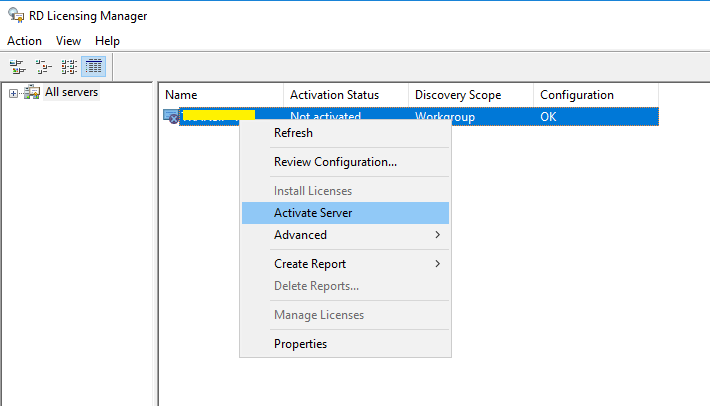
Now the RDS licensing server activation wizard will appear on your screen. Here in the drop-down, you have to selst connection methods.
If your server has internet connectivity, it can automatically establish a connection with Microsoft servers to activate the RDS license server. In cases where no direct internet access is unavailable from the server, you can activate the server through a web browser or by using a phone.
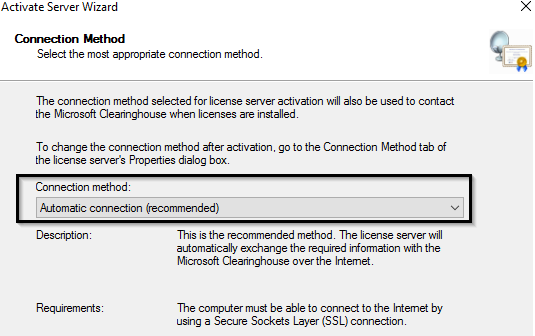
Enter your company information (your name, the company name, your geographic region), and then click Next.
Optionally enter any other company information (for example, email and company addresses), and then click Next.
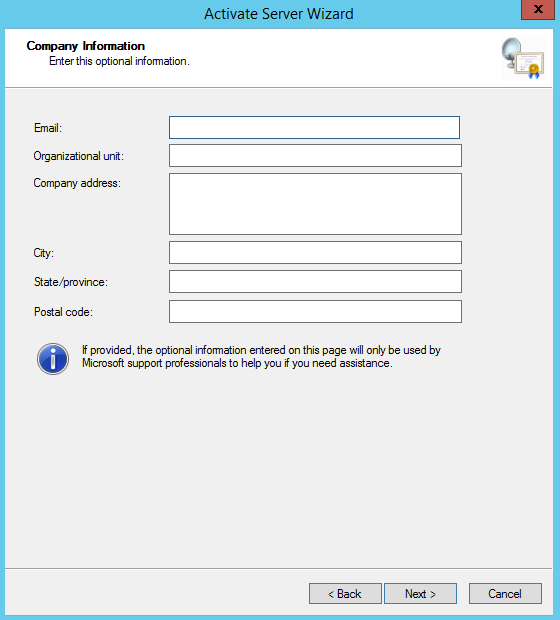
It remains to click the Finish button.

Make sure that the ‘Start Install Licenses Wizard‘ option is not checked (we’ll install the RDS licenses in a subsequent step), and then click ‘Next.
If you right-click the server name in the console and select Review Configuration, you can verify that the RDS License Server is activated and can be used to activate RDSH clients in your domain.
By right-clicking on the server name within the console and choosing ‘Review Configuration,’ you can confirm that the RDS License Server is activated and ready for use in activating RDSH clients within your domain.

This Completes the Activate RDS License Server steps. Now Let’s Proceed with the Install RDS Licence section.
RDS CALs: Types of Remote Desktop Client Access Licenses
Every user or device that connects to Remote Desktop Session hosts requires a client access license (CAL). There are two categories of RDS CALs:
RDS User CALs (Client Access Licenses)
- User-Based Licensing: RDS User CALs are assigned to individual users. Each user who needs to access the RDS environment requires a separate User CAL.
- Flexible: Ideal for scenarios where users need to access the RDS environment from multiple devices (e.g., work computer, personal computer, mobile device).
- Licensing Users: Licenses are tied to specific named users, allowing those users to access RDS from any device.
- User Mobility: Suited for users who are often on the go and access the RDS environment from various locations and devices.
Note: These licenses are not concurrent, i.e., if you have 10 Per Device licenses, only 10 hosts can connect to your RDS server.
RDS Device CALs (Client Access Licenses):
- Device-Based Licensing: RDS Device CALs are assigned to specific devices (computers or thin clients). Each device that accesses the RDS environment needs its own Device CAL.
- Cost-Effective for Shared Devices: If several users share a single device to access the RDS environment (e.g., in a public library or on a shop floor), Device CALs can be more cost-effective.
- Licensing Devices: Licenses are tied to specific devices, allowing any user who logs in to the licensed device to access the RDS environment.
- Device Dedication: Suited for scenarios where devices are dedicated to specific tasks or locations and multiple users use those devices to access RDS.
Note: This type of license is associated with an Active Directory user and issued not permanently but for a specific period. The license is issued for a period of 52 to 89 days (random number).
| RDS 2008 R2 and earlier CAL | RDS 2012 CAL | RDS 2016 CAL | RDS 2019 CAL | RDS 2022 CAL | |
|---|---|---|---|---|---|
| Windows 2008, 2008 R2 session host | Yes | Yes | Yes | Yes | Yes |
| Windows 2012 session host | No | Yes | Yes | Yes | Yes |
| Windows 2012 R2 session host | No | Yes | Yes | Yes | Yes |
| Windows 2016 session host | No | No | Yes | Yes | Yes |
| Windows 2019 session host | No | No | No | Yes | Yes |
| Windows 2022 session host | No | No | No | No | Yes |
| RDS 2008 R2 and earlier CAL | RDS 2012 CAL | RDS 2016 CAL | RDS 2019 CAL | RDS 2022 CAL | |
|---|---|---|---|---|---|
| Windows 2008, 2008 R2 license server | Yes | No | No | No | No |
| Windows 2012 license server | Yes | Yes | No | No | No |
| Windows 2012 R2 license server | Yes | Yes | No | No | No |
| Windows 2016 license server | Yes | Yes | Yes | No | No |
| Windows 2019 license server | Yes | Yes | Yes | Yes | No |
| Windows 2022 license server | Yes | Yes | Yes | Yes | Yes |
If you try to use RDS 2019 Per User CAL in a workgroup (not in a domain), then the RDSH server will automatically terminate a user’s session every 60 minutes, displaying a message: ‘Remote Desktop License Issue: There is a problem with your Remote Desktop license, and your session will be disconnected in 60 minutes”. Therefore, for RDS servers in a Windows Workgroup environment, you need to use only device licensing (Per Device RDS CALs).

Installing RDS CALs on Windows Server 2019/2016
Now we need to install RDS CALs which we have purchased for RDS Licensing Server. For that, we need to open a Licensing Manager:
Open the Server Manager and from the Tools menu go to Remote Desktop Services > Remote Desktop Licensing Manager.
Now you have to Right-click on your server listed in Remote Desktop Licensing Manager and select Install Licenses.

In the next step, we have to select the activation method (Automatic, Online, or by Phone) and the license program (in our case, it is Enterprise Agreement).


The next steps of the wizard will vary depending on the license program you have opted for. If you are using an Enterprise Agreement, you will need to specify its number. On the other hand, if you have selected a License Pack (Retail Purchase), you should input the 25-character product key provided by Microsoft or a certified partner.
Specify the product version (Windows Server 2022/2019/2016), the license type (RDS Per User CAL), and the number of licenses that you intend to install on the server.

Once the process is completed, your server can issue licenses (RDS CAL) to clients. You can access all the license details on the right side of the licensing manager, including the number of CALs issued and the number that remains available. Additionally, you have the option to convert RDS User CALs to Device CALs (or vice versa) using the ‘Convert Licenses’ menu item within the RD Licensing Manager console.

Note: In case you have run out of free RDS licenses, you have the option to reclaim previously issued RDS Device CALs for inactive computers. Up to 20% of Per-Device RDS CALs can be revoked. Per-User CALs cannot be revoked.
How to Create RDS CAL Usage Reports
Within the RDS License Console, you can generate a license usage report. To initiate this process, go to the server menu located on the left side, then select “Create Report” and choose “CAL Usage.”
Configuring RDS Licenses on RD Session Hosts
Once the RDS License Server has been activated and is operational, you can reconfigure the RD Session Host to acquire CAL licenses from this server. This can be achieved through the Server Manager GUI, by using PowerShell, or by configuring it through Group Policy.
To modify the name or address of the licensing server on the RDS host, follow these steps:
- Open Server Manager.
- Navigate to “Remote Desktop Services” and select “Collections.”
- In the upper-right menu, click on “Tasks.”
- Choose “Edit Deployment Properties.”

After that RDS deployment properties will pop up in front of the screen and you have to select RD Licensing select the Remote Desktop licensing mode, and set the RDS license server. Click Add >> OK.
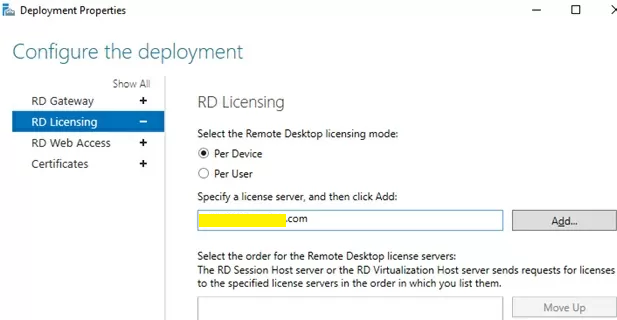
If you want to configure the RDS licensing server parameters through Group Policy, you should create a new Group Policy Object (GPO) and link it to the Organizational Unit (OU) containing your RDS servers.
Alternatively, you can specify the licensing server’s name using the Local Group Policy Editor (gpedit.msc). The RD licensing settings can be found within the following GPO section: Computer Configuration -> Policies -> Administrative Templates -> Windows Components -> Remote Desktop Services -> Remote Desktop Session Host -> Licensing.
There are two Remote Desktop settings that we need to configure:
- Use the specified Remote Desktop license servers – the address of the License Server is set; (if you have more than one server, use commas to separate their names).
- Set the Remote Desktop licensing mode – select RDS CAL license type.

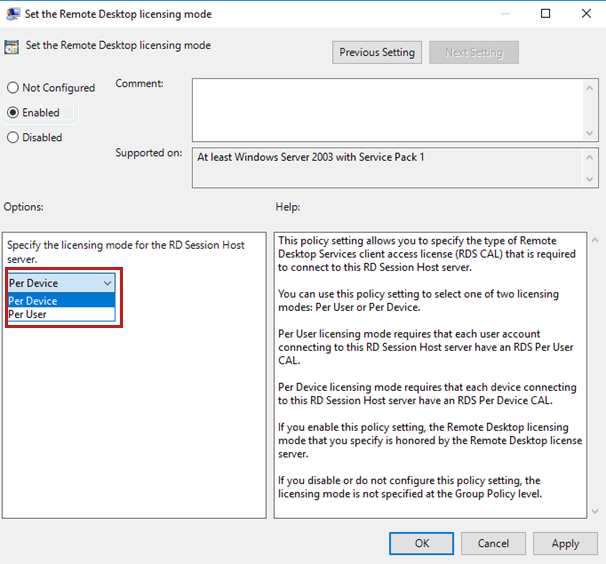
To monitor the RD License Server status and track the number of issued licenses, you can utilize the Remote Desktop Licensing Diagnoser tool. This tool can be accessed through either lsdiag.msc or by navigating to Administrative Tools and selecting “Remote Desktop Services,” and then choosing “RD Licensing Diagnoser.”
If the Remote Desktop Licensing Diagnoser is not already installed on your RDSH servers, you can add it using Server Manager. Navigate to “Features” and then select “Remote Server Administration Tools” -> “Role Administration Tools” -> “Remote Desktop Services Tools” -> “Remote Desktop Licensing Diagnoser Tools.
If the RDSH server is not configured to use an RDS license server, the following warnings will appear in the Licensing Diagnoser console:
- Licenses are not available for this Remote Desktop Session Host server, and RD Licensing Diagnose has identified licensing problems for the RDSH.
- Number of licenses available for clients: 0
- The licensing mode for the Remote Desktop Session Host server is not configured.
- The Remote Desktop Session Host server is within its grace period, but the RD Session Host server has not been configured with any license server.
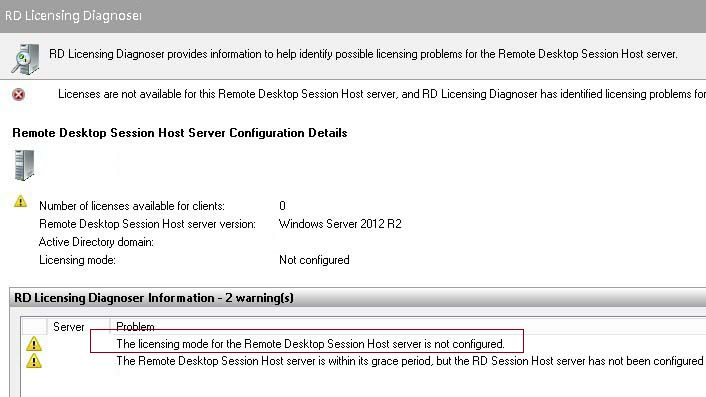
If there are no warnings, and you see the message “RD Licensing Diagnoser did not identify any licensing problems for the Remote Desktop Session Host server”, then the RDSH server can successfully receive RDS CALs for remote users and/or devices.

We hope after this article you can easily configure the Windows license server without any problem. We hope you have found this article helpful. If you have any questions or suggestions, please don’t hesitate to comment in the section below. We will certainly reply to your comments. Also, feel free to share this article with your friends. Thank you!

